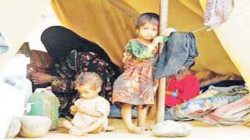Yemen’s deteriorating economic situation continues
YemenExtra
After almost six years of war, Yemen continues to face an unprecedented humanitarian, economic crisis.
Yemen continues to face significant risks of renewed macroeconomic volatility, Without stable sources of foreign exchange.
The aggression has essentially eliminated Yemen exports, weakened the national currency, caused inflation, limited food, and fuel imports, and damaged infrastructure.
The Yemeni rial is vulnerable to downward pressures. A further rial depreciation would immediately have a knock-on effect on the prices of imported commodities with dire economic and humanitarian consequences.
Significant damage to vital public infrastructure has contributed to a disruption of basic services, while insecurity has delayed the rehabilitation of oil exports which increased further compound the economic crisis and humanitarian suffering.
Yemen’s economy shrunk by as much as 16.7% in 2015, only to improve gradually since that date. In 2019, GDP was estimated to have grown by 2.1%, against 0.8% in 2018. According to the updated IMF forecasts from 14th April 2020, due to the outbreak of the COVID-19, GDP growth is expected to fall to -3% in 2020 and pick up to 6.1% in 2021, subject to the post-pandemic global economic recovery.
About 80% of Yemen’s population (24 million) are “at-risk”, of which roughly 14.3 million are in acute need, according to UN estimates. Basic services across the country are on the verge of collapse, including 17.8 million people lacking access to safe water and sanitation and 19.7 million lacking access to adequate healthcare (World Bank).
Economic prospects in 2021 and beyond are uncertain and hinge critically on the political and security situations.
Source: Saba

